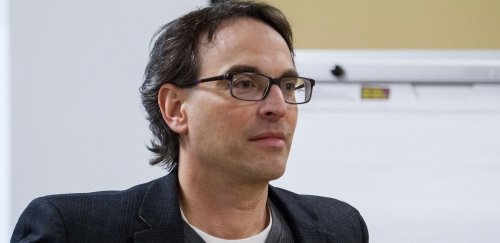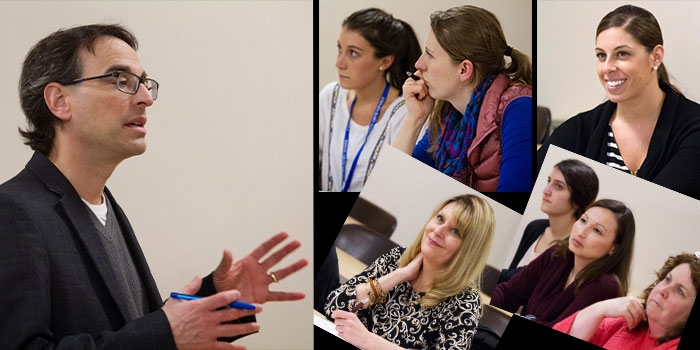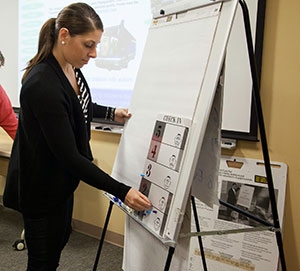Autism on the Rise - How RIC is Changing the Outcomes
- News & Events
- News
- Autism on the Rise - How RIC is Changing the Outcomes

RIC partners with Sherlock Center to create autism education certificate program
In 2014 the Centers for Disease Control (CDC) reported that 1 in 68 children are diagnosed with an autism spectrum disorder (ASD). The prevalence of autism, according to the CDC, has been on the rise since the early 1990s.
To meet the needs of children with autism and to build the capacity of educators and school districts, in 2009 Rhode Island College established the Certificate of Graduate Studies (C.G.S.) in autism education program in partnership with the Paul V. Sherlock Center on Disabilities.
Open to certified teachers and related service providers, this program extends their professional knowledge and skills, and ultimately their capacity to effectively teach and support individuals with autism.
Paul LaCava, associate professor of special education and director of the C.G.S. program, has been working with a range of Rhode Island stakeholders to better the odds for these children.
“Though there is greater awareness of autism – both in the general public and especially in schools,” he said, “there is still a lack of understanding of autism and how to meet the needs of these children. Their most critical need is early intervention.”
On the frontline of intervention are special educators. RIC has trained more than 60 of them, while drawing hundreds of other teachers and related service providers to the Community of Practice (COP) at RIC.
Joanne Weaver ’10 was one of the first graduates of the C.G.S. program. A special education teacher for 34 years, Weaver spent the last 15 of those years teaching children with autism.
She said, “I was so excited when I heard that RIC had instituted a program in autism education. Prior to the establishment of RIC’s program, there was no ASD training in the state. I had to go out of state for specialized training.”
RIC’s two-year certificate program teaches effective interventions for children with autism using evidence-based practices. “Evidence-based practice is the standard that school departments are now using to judge their ASD programs,” said Weaver.
LaCava concurred. He said early intervention, using evidence-based practices, is key to optimal outcomes for children with autism. Though there is not one single practice that can be applied to all individuals with autism due to the wide range in degree of ASD, he said, all individuals with ASD need environmental and social/emotional supports.
LaCava teaches one of the six courses in the program. He said a few effective environmental supports would be a visual timer that gets smaller as time elapses or a daily schedule in pictures or in words, or a combination of both, that are visible and accessible to the child. Because of the diversity of autism, these supports would be individualized for each child.
“Children with ASD typically need a structured environment; they need routine,” LaCava said. “Having a picture or the written word allows them to refer back to the teacher’s directions or to the content multiple times, as needed, whereas verbal directions can be easily forgotten.”

Along with environmental supports, social/emotional supports are needed for children with autism. “One area of difficulty for these children is self-regulating their behavior, which includes understanding and managing emotions,” said LaCava.
In the C.G.S. program, LaCava and other faculty teach educators a variety of social/emotional supports that they can use in their classrooms, including the Incredible 5-Point Scale. Numbered one to five, the 5-Point scale begins with a happy face at number one that becomes progressively less happy as the scale rises to number five.
In application, the child’s teacher might notice, for example, that the child is arching his back and beginning to complain, LaCava said. The teacher would then ask the child to identify what he is feeling and to rate the feeling from one to five, by pointing to the 5-Point scale.

One, on the scale, might mean that the child is feeling calm, while a four might mean the child is feeling stressed or anxious. The teacher might then say, “To get back to one, you might want to do some push-ups, take a quick walk, get a drink of water, or vent and verbalize. Here are some things that you can do so that you can get to a safe, quiet place to calm down.” In this way, children are taught the connection between their feelings and their behavior and how to self-regulate.
In the C.G.S. program, students are also taught to understand the perspective of the ASD child. They learn assessment methods – how to observe the child for their individualized needs and interview their parents and teachers. They learn how to implement curriculum, programming and teaching plans. Various technologies and resource information are provided. And in their practicums, students apply what they have learned to their own classrooms.
Current student Debbie Bauzyk said that she enrolled in the C.G.S. program to better herself as a special education teacher. “I have a few students this year on my caseload with autism, but given the rise in the number of students with ASD, it is inevitable that my numbers will increase yearly,” she said. “Since beginning the program, I find that I am better able to understand and work with my ASD students, I am better able to educate faculty and I am better able to facilitate cooperative learning.”
Former student Leslie Paterson ’12, said, “I came into the program with practical, clinical experience in working with people with autism. Not only did the program help me develop my skills, it allowed me to move into a leadership position and develop a system-wide program to support students with autism. As a result, I have been able to influence many, many lives for the better.”
Weaver, too, became a leader in the field of autism. “The program gave me the confidence to take on the new role of autism consultant,” she said. “I now serve ASD students of varying ages and abilities in school districts throughout the state.”
Graduates of the program not only build a professional community, they build a community of practice. RIC’s Community of Practice (COP) on ASD was created in partnership with the Rhode Island Technical Assistance Program (RITAP). Susan Constable, autism coordinator at RITAP, directs the COP and also teaches one of the certificate program practicums. Amy Grattan and Deb Arenberg of the Sherlock center also teach in the C.G.S. program and assist with the COP.
The COP is a professional development community for current students and graduates of the certificate program and is open to other professionals who work in the field of autism, such as speech language pathologists and school counselors. It is structured as a forum where practitioners can exchange and gather new information in the ever-changing field of autism research. With meetings three-to-four times a year, the COP has drawn several hundred participants, the majority of whom are educators.
Future ASD programming, said LaCava, will include course content for adult ASD issues; ASD training for RIC faculty and staff; more conferences and professional development opportunities; and promotion of the self-determination and self-advocacy of individuals with ASD.
“With the increase in autism over the past 20 years and with emphasis on inclusion, so many educators now have the opportunity to work with these amazing students,” said LaCava. “People with autism guide us and work with us. Listening to and learning from them is so critical in our journey.”
